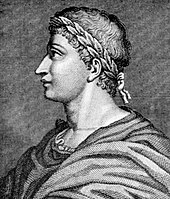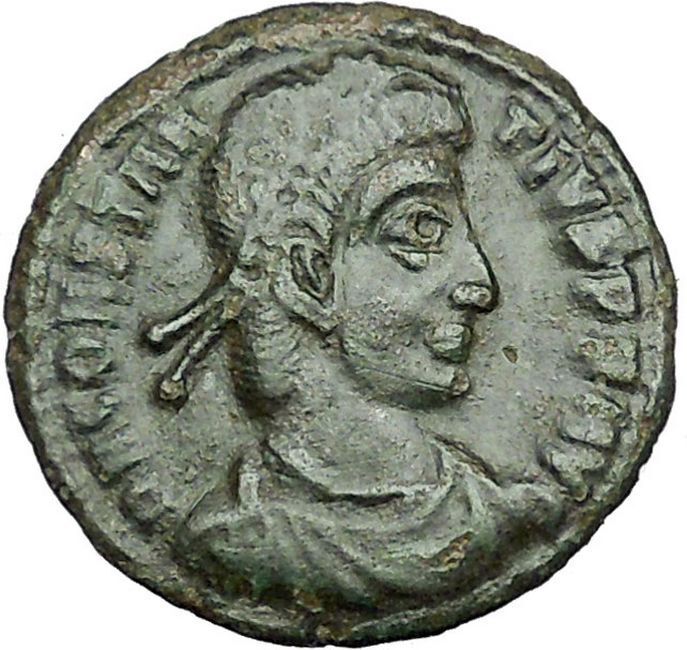|
Arcadius – Roman Emperor: 383-408 A.D. –
Bronze AE4 12mm (1.24 grams) Struck at the mint of Alexandria 383-384 A.D.
Reference: Alexandria, RIC IX 19d
DN ARCADIVS PF AVG, pearl-diademed, draped, cuirassed bust right
VOT X MVLT XX within wreath. Mintmark: ALE delta.
You are bidding on the exact item pictured,
provided with a Certificate of Authenticity and Lifetime Guarantee of
Authenticity.
A laurel wreath is a circular
wreath
made of interlocking branches and leaves
of the
bay laurel
(Laurus nobilis), an aromatic
broadleaf evergreen, or later from spineless butcher’s broom (Ruscus
hypoglossum) or cherry laurel (Prunus
laurocerasus). In
Greek mythology
,
Apollo
is represented wearing a laurel wreath
on his head. In
ancient Greece
wreaths were awarded to victors,
both in athletic competitions, including the ancient
Olympics
made of wild olive-tree known as “kotinos“
(κότινος),[1]
(sc. at
Olympia
) and in poetic meets; in
Rome
they were symbols of martial victory,
crowning a successful commander during his
triumph
. Whereas ancient laurel wreaths are
most often depicted as a
horseshoe
shape, modern versions are usually
complete rings.
In common modern idiomatic
usage it refers to a victory. The
expression “resting on one’s laurels” refers to someone relying entirely on
long-past successes for continued fame or recognition, where to “look to one’s
laurels” means to be careful of losing rank to competition.
Academic use

Ovid
with laurel wreath, common in
poets.
In some countries the laurel wreath is used as symbol of the
master’s degree
. The wreath is given to young
masters in the
graduation ceremony
of the university. The word
“Laureate”
in ‘poet
laureate‘ refers to being signified by the laurel wreath. The
medieval Florentine poet and philosopher
Dante Alighieri
,[dubious
–
discuss
] a graduate of the
Sicilian School
, is often represented in
paintings and sculpture wearing a laurel wreath.
Laureato[3]
is the term used in Italy
to refer to any graduated student. In
some italian regions (Veneto,
Friuli-Venezia Giulia
and
Trentino
), right after the graduation ceremony
(in Italian: laurea), the student receives a laurel wreath and is allowed
to wear it for the rest of the day. This tradition was born in the
University of Padua
and since the end of the
19th century is common to all
northeastern Italian
universities.
At
Connecticut College
in the United States,
members of the junior class carry a laurel
chain
, which the seniors pass through during
commencement. It represents nature and the continuation of life from year to
year. Immediately following commencement, the junior girls write out with the
laurels their class year, symbolizing they have officially become seniors and
the cycle will repeat itself the following spring.
At
Mount Holyoke College
in
South Hadley, Massachusetts
, United States,
laurel has been a fixture of
commencement
traditions since 1900, when
graduating students carried or wore laurel wreaths. In 1902, the chain of
mountain laurel
was introduced; since then,
tradition has been for seniors to march across campus, carrying and linked by
the chain. The mountain laurel represents the
bay laurel
used by the
Romans
in wreaths and crowns of honor.[4]
At Reed College
in
Portland, Oregon
, United States, members of the
senior class receive laurel wreaths upon submitting their senior
thesis
in May. The tradition stems from the use
of laurel wreaths in athletic competitions; the seniors have “crossed the finish
line,” so to speak.
At
St. Mark’s School
in
Southborough, Massachusetts
, students who
successfully complete three years of one classical language and two of the other
earn the distinction of the Classics Diploma and the honor of wearing a laurel
wreath on Prize Day.
In Sweden
, those receiving a Doctorate or an
Honorary Doctorate
at the Faculty of Philosophy
(meaning Philosophy, Languages, Arts, History and Social Sciences), receive a
laurel wreath during the ceremony of conferral of the degree.
Architectural and decorative arts motif

“Victory, A Knight Being Crowned With A Laurel Wreath” by
Frank Dicksee
.
The laurel wreath is a common motif in
architecture
,
furniture
, and
textiles
. The laurel wreath is seen carved in
the stone and decorative plaster works of
Robert Adam
, and in
Federal
,
Regency
,
Directoire
, and
Beaux-Arts
periods of architecture. In
decorative arts, especially during the
Empire period
, the laurel wreath is seen woven
in textiles, inlaid in marquetry, and applied to furniture in the form of gilded
brass mounts.
Alfa Romeo
added a laurel wreath to their
logo after they won the inaugural Automobile World Championship in
1925 with the
P2
racing car.
Flavius
Arcadius (377/378–1 May 408) was
Byzantine Emperor
in the Eastern half of the
Roman
Empire
from 395 until his death.
//
Arcadius was born in
Hispania
,
the elder son of
Theodosius I
and
Aelia Flaccilla
, and brother of
Honorius
, who would become a
Western Roman Emperor
. His father declared him an
Augustus
and co-ruler for the
Eastern half of the Empire
in January, 383. His younger brother was also
declared Augustus in 393, for the Western half.
As emperors, Honorius was under the control of the Romanized
Vandal
magister militum
Flavius
Stilicho
while Arcadius was dominated by one of his ministers,
Rufinus
. Stilicho is alleged by some to have wanted control of both
emperors, and is supposed to have had Rufinus assassinated by Gothic mercenaries
in 395; though definite proof of Stilicho’s involvement in the assassination is
lacking, the intense competition and political jealousies engendered by the two
figures compose the main thread of the first part of Arcadius’ reign. Arcadius’
new advisor, the eunuch
Eutropius
, simply took Rufinus’ place as the power behind the Eastern
imperial throne.
Arcadius was also dominated by his wife
Aelia
Eudoxia
, who convinced her husband to dismiss Eutropius, who was holding the
consulate, at the height of his power, in 399. That same year, on the 13th July,
Arcadius issued an edict ordering that
all remaining non-Christian temples should be immediately demolished
.
Eudoxia’s influence was strongly opposed by
John Chrysostom
, the
Patriarch of Constantinople
, who felt that she had used her family’s wealth
to gain control over the emperor. Eudoxia used her influence to have Chrysostom
deposed in 404, but she died later that year. Eudoxia gave to Arcadius four
children: three daughters,
Pulcheria
,
Arcadia and Marina, and one son, Theodosius, the future Emperor
Theodosius II
.
Arcadius was dominated for the rest of his rule by
Anthemius
, the
Praetorian Prefect
, who made peace with Stilicho in the West. Arcadius
himself was more concerned with appearing to be a pious
Christian
than he was with political or military matters, and he died, only
nominally in control of his empire, in 408.
>
Character and works
In this reign of a weak emperor dominated by court politics,
a major theme was the ambivalence felt by prominent individuals and the court
parties that formed and regrouped round them towards
barbarians
,
which in Constantinople at this period meant
Goths
. In the
well-documented episode that revolved around
Gainas
, a
number of Gothic foederati stationed in the capital were massacred, the
survivors fleeing under the command of Gainas to
Thrace
, where
they were tracked down by imperial troops and slaughtered and Gainas dispatched.
The episode has been traditionally interpreted as a paroxysm of anti-barbarian
reaction that served to stabilise the East. The main source for the affair is a
mythology à clef by
Synesius
of
Cyrene, Aegyptus sive de providentia, (400)
an Egyptianising allegory that embodies a covert account of the events, the
exact interpretation of which continues to baffle scholars. Synesius’ De
regno, which claims to be addressed to Arcadius himself, contains a tirade
against Goths.
A new
forum
was built in the name of Arcadius, on the seventh hill of
Constantinople, the XÄ“rolophos, in which a
column
was begun to commemorate his ‘victory’ over Gainas (although the
column was only completed after Arcadius’ death by
Theodosius II
).
The
Pentelic marble
portrait head of Arcadius (illustration) was
discovered in Istanbul close to the Forum Tauri, in June 1949, in excavating
foundations for new buildings of the University at
Beyazit
.
The neck was designed to be inserted in a torso, but no statue, base or
inscription was found. The
diadem
is a
fillet with rows of pearls along its edges and a rectangular stone set about
with pearls over the young emperor’s forehead.
|













